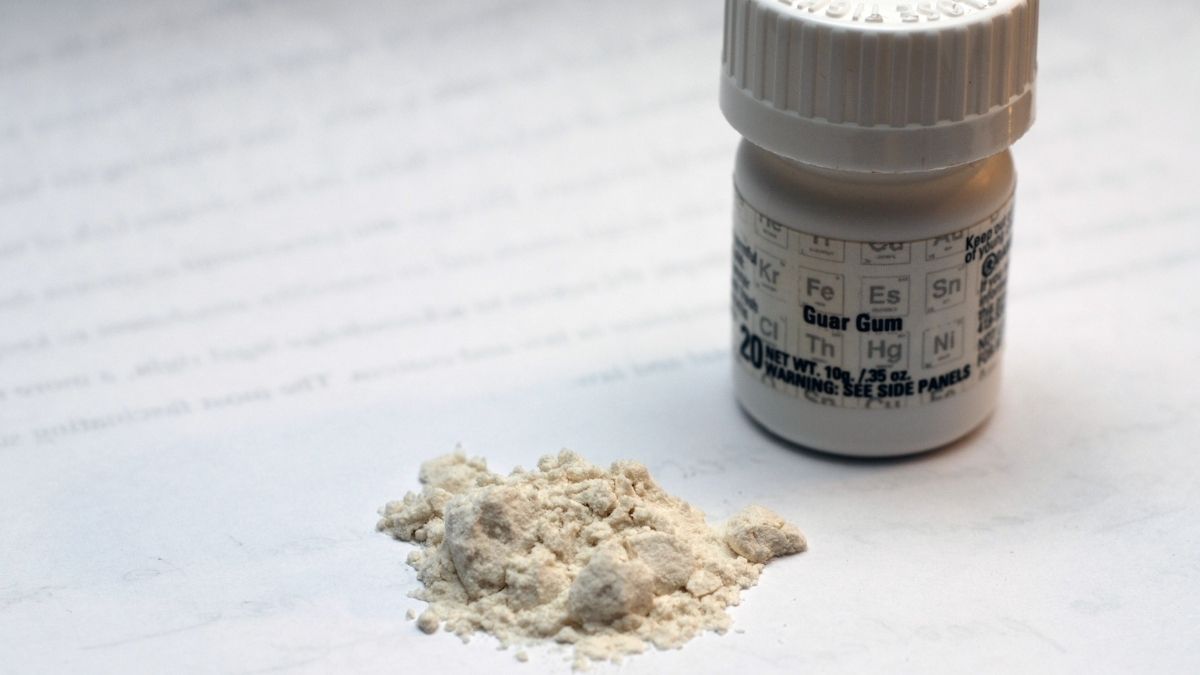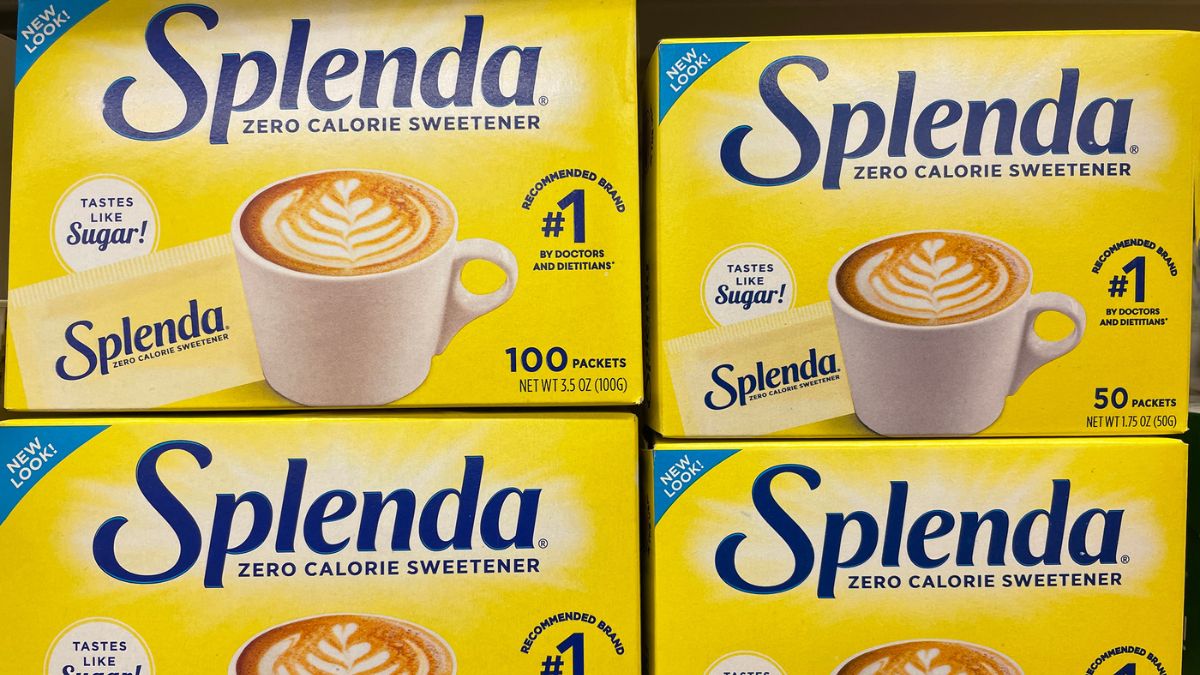Answer: Yes.

Guar gum is a widely used ingredient. Guar gum, commonly known as guaran, is a polysaccharide derived from guar beans which have various useful features in the food business.
But, is it vegan? Yes! Guar gum is a vegan product. It’s basically powdered guar bean endosperm. The seeds of guar beans were dehusked, processed, and screened to produce an off-white and free-flowing powder.
In any case, it’s completely vegan. However, because of its extensive use in animal products, it is occasionally misclassified as an animal-based component. For example, it acts as a binding agent in meat as a thickening in yogurt, milk, and kefir.
People are sometimes wary about the origins of food additives due to their use for animal products. So, to clear up any confusion, we’ll go on to a more in-depth discussion of guar gum.
Table of Contents
What Is Guar Gum?
Guar gum, also known as guar flour and guaran, is made from the guar plant’s bean.
The endosperm of the guar bean is separated from the remainder of the guar bean and processed into a white-ish to a yellowish powdery substance to make the fine gum powder. This powder is being used as a stabilizer, thickener, and/or emulsifier in a variety of foods, including gravies, baked goods, sauces, jams, dressings, dairy substitutes, and dairy products. Guar gum is present in textiles, cosmetics, toothpaste, pharmaceuticals, and paper goods, in addition to food.
The active substance responsible for the powder’s adaptability, characteristics, and possible health advantages is galactomannan, a kind of soluble fiber present in guar beans.
Why Is Guar Gum Considered Vegan?
Guar Gum Is Used In Certified Vegan Products
Guar gum, like cornstarch, tapioca flour, and locust bean gum, is commonly used in culinary items as a stabilizer and thickening. This is due to its ability to generate hydrogen bonds in liquid.
Guar gum powder has a wide range of applications, from the beverages and food sectors to the industrial sector, with the food industry being its primary market. Guar gum, in essence, aids in the mixing of components and the prevention of ingredient separation.
Baked Goods. Guar gum could be used as a substitute for white flour in baked products. When utilizing typical gluten-containing flours, the protein gluten serves as a thickener in batters and doughs, trapping air bubbles and making baked products fluffy and light. When gluten is removed from a recipe, an emulsifier or thickener, such as guar gum, must be added.
Guar gum boosts dough output, provides higher resilience, and improves both shelf life and texture when used in baking recipes. When it is used in pie filling, it also prevents syneresis or the displacement of water from the “gelled” filling. Preventing syneresis aids in the preservation of the pie crust’s crispness.
Dairy Products. Guar gum is commonly found in yogurt, dairy foods, and liquid cheese. Guar gum helps preserve the texture and homogeneity of sherbet and ice cream when used in these products. Guar gum, as an emulsifier, contributes to a smooth and constant consistency, as well as readily disseminated components.
Vegan Products. Guar gum offers the same advantages for non-dairy alternatives as it does for dairy products in terms of improving and thickening texture. Guar gum is commonly added to plant milk to enhance the viscosity of the liquid and improve mouthfeel. Guar gum may be used as a vegan replacement to gelatin in some recipes.
Other Uses For Guar Gum. Guar gum may be found in your pantry. It functions as a binder when used with meat products. When added to condiments like salad dressing and barbecue sauce, it enhances their look and keeps the contents from separating. Guar gum is also found in a variety of meals, including canned soups and fish in sauce, as well as quick oatmeal and frozen goods.
Guar gum has industrial use in addition to food. The shale oil and gas extraction sectors, for example, utilize a significant quantity of guar gum produced. Guar gums, among other choices, are the recommended thickeners for improved oil recovery. Guar gum is also utilized in the textile, paper, explosives, pharmaceutical, and cosmetic sectors.
Guar Gum Isn’t Processed In Whey Protein
Xanthan gum is a widely used additive that has many of the same qualities as guar gum. While guar gum is made from guar beans, xanthan gum is derived from cheese waste products.
Take note that Xanthan Gum has been deemed non-vegan by the majority of the vegan community. Not all xanthan is manufactured on whey, and there’s sometimes no way to know for sure how the components were produced, however, it’s a bit of a blurred line.
Guar gum, unlike Xanthan Gum, is derived from guar beans. It is not tainted by controversy and is completely vegan.
A Perfect Gelatin Alternative
Because of its similarities to gelatin when combined with water, guar gum is frequently employed as a replacement. If used, for this reason, one-sixth of the amount of gelatin is replaced with one-sixth of the proportion of guar gum.
It helps to retain the “mouth feel” of dairy foods, which might otherwise appear thin or watery, and hence enhances the smoothness of vegan milk and cream substitutes. In some cases, guar gum may instantly change a non-vegan or even non-vegetarian dish into a vegan-friendly one. Also, it is often used in various recipes to hold and thicken mixes and dough.
Is Guar Gum Good For You?
It’s somewhat of a yes or no scenario.
When used in conformity with appropriate manufacturing or feeding practices, this chemical is usually regarded as safe. Case studies have indicated that guar gum could aid in the treatment of diabetes by slowing the absorption of glucose in the body.
Some manufacturers promoted guar gum as a kind of a possible weight reduction aid, however, the FDA has prohibited such applications. Overconsumption has been shown to have a negative impact on your body’s ability to absorb nutrients from meals.
Is Guar Gum Gluten-Free?
Guar gum is regarded as a gluten-free product since it is not derived from any of the gluten crops such as barley, wheat, or rye, and it was prepared in a method that prevented gluten cross-contamination.
In fact, guar gum, along with xanthan gum, tends to thicken the batter and keep the components from separating in gluten-free baked products. It also assists to trap air inside the mixture, causing the batter to rise when baked. This helps the baked items appear more like traditional wheat-flour-based baked goods.
Why Guar Gum Is A Perfect Gluten Replacement
Guar gum powder is an ideal substitute for a classic vegan who is concerned with cruelty-free extraction techniques, no animal components or testing, and ongoing environmental concerns.
It’s also all-natural, with no chemicals added throughout the manufacturing process, less expensive, and typically gives better results than some other baking options. Furthermore, in the context of guar gum powder, it has the additional benefit of being entirely USDA-certified organic.
Where Can I Buy Guar Gum?
Fortunately, guar gum is widely available online for individuals who want to utilize it in baking or home cooking recipes. The following are some of the greatest guar gum brands:
Herbalia Guar Gum Powder
This guar gum powder is high in fiber and GMO-free, allowing it an all-natural vegan-friendly gelatin alternative.
Anthony’s Organic Guar Gum Powder
It is made using organically produced guar gum beans and has been batch-tested and gluten-free. That is another plant-based thickening agent made in India and packaged in the United States.
Bob’s Red Mill Guar Gum
This vegan alternative to cornstarch has 8 times the thickening ability of cornstarch.
Guar Gum Vegan Substitutes
If you look carefully, you can find guar gum at the shop. However, if you can’t locate any in your nation, there are plenty of other possibilities. Here are a few alternatives.
Agar-Agar
This is another vegan binding agent that is commonly used in confectionery. Agar-agar is made from seaweed. It’s simpler to find in a Chinese supermarket. If guar gum is called for in a recipe, use agar-agar as a substitute.
Xanthan Gum
Xanthan gum works in the same way as guar gum does. This is a binder that may be found in a range of culinary products. Bacteria produce it through the fermentation of fructose and glucose. It is vegan, however as previously said, there is a contentious matter that vegans should avoid. If you need guar gum and can’t seem to find it, try xanthan gum, but make sure it’s vegan.
Flax Seeds
Flax seeds are frequently used to substitute eggs in vegan dishes, and they are comparable to guar gum in certain ways. Flax seeds, like guar, are not utilized in their natural condition and must be crushed and blended with before being used.
Although less efficient as binding agents than guar, flax seeds are quite popular in gluten-free cooking.
The Final Word
So that wraps it up. Guar gum is a common vegan substitute for gelatin and is also extremely efficient as a thickening agent. Whenever you find guar gum on an ingredient list, you know it’s a positive omen. It should be noted there is always the risk of non-vegan substances being used, so keep this in mind.
However, be cautious of your guar gum use because, while it offers health advantages, it may also be harmful if consumed in excess.




